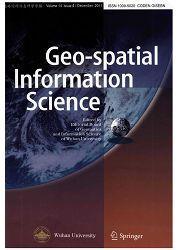ST-GWLR: combining geographically weighted logistic regression and spatiotemporal hotspot trend analysis to explore the effect of built environment on traffic crash
IF 5.5
1区 地球科学
Q1 REMOTE SENSING
引用次数: 0
Abstract
Road traffic crashes are becoming thorny issues being faced worldwide. Traffic crashes are spatiotemporal events and the research on the spatiotemporal patterns and variation trends of traffic crashes has been carried out. However, the impact of built environment on traffic crash spatiotemporal trends has not received much attention. Moreover, the spatial non-stationarity between the variation trends of traffic crashes and their influencing factors is usually neglected. To make up for the lack of analysis of built environment factors influencing spatiotemporal hotspot trends in traffic crashes, this paper proposed a method of “ST-GWLR” for analyzing the influence of built environment factors on spatiotemporal hotspot trends of traffic crashes by combining the spatiotemporal hotspot trend analysis and Geographically Weighted Logistic Regression (GWLR) modeling methods. Firstly, the traffic crash spatiotemporal hotspot trends were explored using the space-time cube model, hotspot analysis, and Mann-Kendall trend test. Then, the GWLR was introduced to capture the spatial non-stationarity neglected by the classic Global Logistic Regression (GLR) model, to improve the accuracy of the model estimation. GWLR model is used for the first time to analyze the significant local correlation between the traffic crash spatiotemporal hotspot trends and the built environment factors, to accurately and effectively identify the built environment factors that have significant influences on the hotspot trends of traffic crashes. The performance of the GWLR models and GLR models was examined and compared sufficiently. The results showed that the proposed ST-GWLR, which captured spatial non-stationarity, performed better than the classic GLR combined with spatiotemporal analysis, and improved the prediction accuracy of the models by 14.9%, 13.9%, and 15.1%, respectively. There were significant local correlations between intensifying hotspots and persistent hotspots of traffic crashes and the built environment factors. The findings of this paper have positive implications for traffic safety management and urban built environment planning.ST-GWLR:结合地理加权逻辑回归和时空热点趋势分析探讨建成环境对交通事故的影响
道路交通事故正在成为世界范围内面临的棘手问题。交通事故是一个时空事件,对交通事故的时空格局和变化趋势进行了研究。然而,建筑环境对交通事故时空变化趋势的影响尚未得到重视。此外,交通事故变化趋势与其影响因素之间的空间非平稳性往往被忽略。针对建筑环境因素对交通事故时空热点趋势影响分析的不足,本文将时空热点趋势分析与地理加权Logistic回归(GWLR)建模方法相结合,提出了建筑环境因素对交通事故时空热点趋势影响分析的“ST-GWLR”方法。首先,利用时空立方体模型、热点分析和Mann-Kendall趋势检验,探索交通事故时空热点趋势。在此基础上,引入全局逻辑回归来捕捉经典全局逻辑回归模型所忽略的空间非平稳性,提高模型估计的精度。首次利用GWLR模型分析交通事故时空热点趋势与建成环境因子之间的显著局部相关性,准确有效地识别对交通事故热点趋势有显著影响的建成环境因子。对GWLR模型和GLR模型的性能进行了充分的检验和比较。结果表明,基于时空非平稳性的ST-GWLR比经典GLR结合时空分析的模型预测精度分别提高14.9%、13.9%和15.1%。交通事故热点加剧和热点持续与建成环境因子存在显著的局部相关性。研究结果对交通安全管理和城市建设环境规划具有积极的启示意义。
本文章由计算机程序翻译,如有差异,请以英文原文为准。
求助全文
约1分钟内获得全文
求助全文
来源期刊

Geo-spatial Information Science
REMOTE SENSING-
CiteScore
10.10
自引率
28.30%
发文量
710
审稿时长
31 weeks
期刊介绍:
Geo-spatial Information Science was founded in 1998 by Wuhan University, and is now published in partnership with Taylor & Francis. The journal publishes high quality research on the application and development of surveying and mapping technology, including photogrammetry, remote sensing, geographical information systems, cartography, engineering surveying, GPS, geodesy, geomatics, geophysics, and other related fields. The journal particularly encourages papers on innovative applications and theories in the fields above, or of an interdisciplinary nature. In addition to serving as a source reference and archive of advancements in these disciplines, Geo-spatial Information Science aims to provide a platform for communication between researchers and professionals concerned with the topics above. The editorial committee of the journal consists of 21 professors and research scientists from different regions and countries, such as America, Germany, Switzerland, Austria, Hong Kong and China.
 求助内容:
求助内容: 应助结果提醒方式:
应助结果提醒方式:


